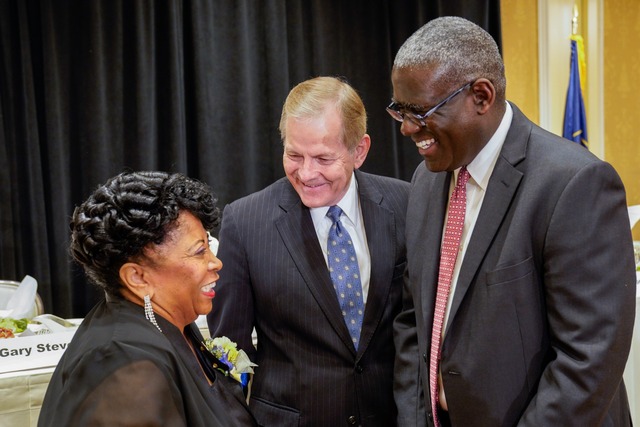
Race and the Church of Jesus Christ: All Are Alike Unto God
(from the LDS Church Newsroom)
The gospel of Jesus Christ is for everyone. The Book of Mormon states, “black and white, bond and free, male and female; … all are alike unto God” (2 Nephi 26:33). This is the Church’s official teaching.
People of all races have always been welcomed and baptized into the Church since its beginning. In fact, by the end of his life in 1844 Joseph Smith, the founding prophet of The Church of Jesus Christ of Latter-day Saints, opposed slavery. During this time some black males were ordained to the priesthood. At some point the Church stopped ordaining male members of African descent, although there were a few exceptions. It is not known precisely why, how or when this restriction began in the Church, but it has ended. Church leaders sought divine guidance regarding the issue and more than three decades ago extended the priesthood to all worthy male members. The Church immediately began ordaining members to priesthood offices wherever they attended throughout the world. (See also: Race and the Priesthood)
The Church unequivocally condemns racism, including any and all past racism by individuals both inside and outside the Church. In 2006, then Church president Gordon B. Hinckley declared that “no man who makes disparaging remarks concerning those of another race can consider himself a true disciple of Christ. Nor can he consider himself to be in harmony with the teachings of the Church. Let us all recognize that each of us is a son or daughter of our Father in Heaven, who loves all of His children.”
‘All are alike unto God,’ Elder Stevenson says at NAACP luncheon
(Excerpts from LDS Church News)

Speaking at the 36th Annual Dr. Martin Luther King Jr. Memorial Luncheon in Salt Lake City, Elder Stevenson of the Quorum of the Twelve Apostles addressed the topic, “All are alike unto God.”
Elder Stevenson thanked the NAACP for all the organization does to “eliminate race-based discrimination and ensure the health and well-being of all persons.”
Quoting Proverbs 29:18, Elder Stevenson spoke about the importance of vision, noting “where there is no vision, the people perish.”
“The Church’s relationship with the NAACP has evolved from acquaintance to friend, to linking arms, to locking arms. This could not have happened without vision.”
Elder Stevenson began his remarks saying he was “deeply saddened and hurt” by an error included in a recent Church manual referencing outdated commentary about race.
“Our position as a Church is clear. We do condemn all racism, past or present, in any form and we disavow any theory that black or dark skin is a sign of a curse. We are brothers and sisters and I consider you friends.”
How Some Latter-day Saints in the Past Misinterpred “Black” and “Curse” in the Scriptures
I became a member of the Church of Jesus Christ of Latter-day Saints after the so-called revelation on the priesthood, but for a long time there was confusion, and even resentment, about the older policy of the LDS Church.

The article, How We Misinterpret “Black” and “Curse” in the Scriptures: Insights from an African American Convert by Marvin Perkins, of which I share a few paragraphs, provides some very valuable insight.
Converting to the LDS Faith
“I had a definite advantage when I investigated The Church of Jesus Christ of Latter-Day Saints in that I knew who God was,” Perkin says. “I knew that Jesus Christ died for all in the human family and that God was no respecter of persons.” When Perkins began investigating the Church in 1988, he says members “were lovingly telling me that I was cursed, was less valiant in the pre-existence, and could not inherit the celestial kingdom but should join anyway because there were some blessings for me.”…
Perkins had no doubt these teachings didn’t resonate with what he already knew about God and what he learned about the gospel. “It really started to dampen the desire I had to join the Church, but God reminded me of the powerful spiritual witness He had given me in answer to my prayer asking Him if this was truly His restored gospel,” Perkins says. “No sin, fault, or unkind word, no matter how long perpetuated, could change that from being true, because God had told me. . . . With that reminder, I joined in faith that He would help me to find the answers that I could then share in helping to build His kingdom.”…
Misunderstanding the Scriptures
Much of the misunderstanding Perkins finds among Latter-day Saints stems from reading the scriptures using modern definitions of words and idioms instead of understanding them in their ancient context…
The Word Black in the Scriptures
“Like most, I grew up using the term black in reference to people of African descent, because it was widely accepted by all cultures,” Perkins says. “So it’s understandable that many would read the scriptures and associate the word ‘black’ in all of its forms, relating to man, in the same way they believe it to be fact in our society. The Saints, and those of other faiths as well, instinctually assume that this word is in reference to race, nationality, or color of skin. . . . The LDS version of the King James Bible and the Book of Mormon help us to understand that the word black is actually a Hebrew idiom, meaning gloomy, dejected, or spiritual darkness, and has nothing to do with skin tone. Though we have this clarity in the scriptures that we carry with us daily, few members are aware that this insight is there.”…
He continues, “We see in Jeremiah 8:21, the LDS version of the King James Bible footnotes the word ‘black’ where it is defined as a Hebrew idiom, dealing with the mental, emotional, or spiritual state of the individual.” He further notes that the scripture reference guide can accelerate our learning on this topic and that other passages of scripture connect to or contain similar footnotes as the one found in Jeremiah 8:21, placing the use of the word “black” in the context of its common meaning in Hebrew as indicating a spiritual not a physical state. “If the word black is not dealing with race or actual skin color, then the feasting mind is opened to many possibilities to explore, such as maybe the same is the case in the Book of Mormon passages that describe a skin of blackness or whiteness (See 2 Nephi 5:21 and 3 Nephi 3:15),” Perkin says….
Considering that Lehi and his family were Jewish descendants, it makes sense that they would be familiar with and even utilize Hebrew idioms similar to those in the Bible. “Upon examining [2 Nephi 5:21 and 3 Nephi 3:15], readers are directed to 2 Nephi 30. There they find skin being tied to ‘scales of darkness’ over the eyes,” Perkins says. “This too is an indication of something mental, emotional, or spiritual and not physical. When you follow the footnote added in the 1981 edition of the Book of Mormon, one finds clarity in the understanding. The footnote reads ‘darkness spiritual; spiritual blindness.’” …
The Word Curse in the Scriptures
Another commonly misunderstood word used within the scriptures and our Church culture is the term “curse.” About this word, Perkins clarifies, “The use of the word curse is very common in the Church today and has been since I joined some 30 years ago. It’s common to hear statements like ‘dark skin is a curse,’ ‘blacks are cursed,’ ‘the Lamanites were cursed,’ ‘it’s because of the curse of Cain or the curse of Ham,’ etc. The uses of these terms, unfortunately, have been taught in the Church for so long that all seem certain that they’re using the expression correctly. That is until I ask them a simple question—’What is a curse?’ The only thing that is common at that point is the silence or long delay before each will utter a certainly uncertain response. It’s amazing that a word that they believe is so damning can be used so freely and frequently without even understanding its meaning….
“We have a section in the scripture reference guide that we created, dedicated to the study of scriptural curses relating to the human family. As one studies these passages, they’ll gain an understanding of exactly what a curse is: a separation from God, His path, and His ways, due to our choice to sin. By understanding what a curse is, they also become clear on what it is not. For example, distance from God, due to our transgressions, cannot impact skin color. Therefore, skin color cannot be a curse. And based upon 1 Samuel 16:7, neither can it be the sign of the curse, as was so widely taught.”…
Truths from the Scriptures
“From the earliest days of the restored gospel, one key message delivered from the Lord in January 1831 to Joseph Smith to pen as scriptural commandment was to ‘be one.’ The critical importance of being one was emphasized in the very next line ‘and if ye are not one ye are not mine’ (D&C 38:27). Yet at that time in our nation, there was a great inequality of man, wherein the division and atrocities levied by brother against brother, and sister against sister, were an acceptable and even expected facets of our society.”…

The inability for the Saints of the Church to fully embrace or comprehend the Savior’s messages and commandments was not only a struggle for members in the 1800s but for members in our time and in Christ’s time as well….
“Our history is a blessing, one that we can learn so much more from if we’d simply first seek to truly understand it,” Perkins says. “Once understanding the truths, it’s essential to embrace the bad along with the good, without defense. When the Spirit of the Lord confirmed the truthfulness of the restored gospel to me in 1988, nothing could change that from being true. Unfortunately, so many believe that if they find unflattering things within our history, then this means that the Church can’t be true. Nothing could be farther from the truth. These are those with cultural testimonies. In order to effectively move beyond our history and be a united church, those cultural testimonies would need to be converted to spiritual testimonies. This can only come by following Christ alone.”
He continues, “This is a church of continuing revelation. The Lord told all in the first book of commandments for establishing the restored gospel that there would be errors, sins, etc. in building and leading His church (see D&C 1:24-28).
